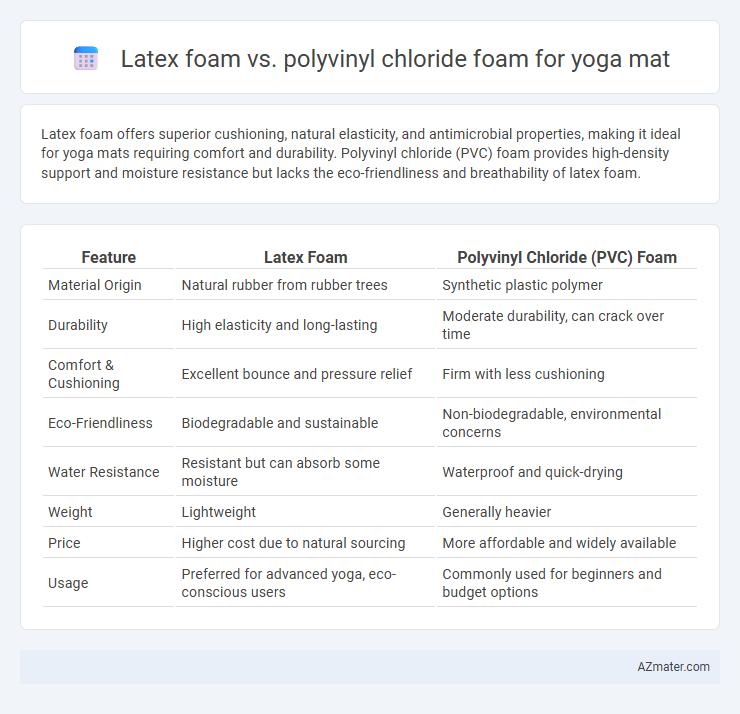Latex foam offers superior cushioning, natural elasticity, and antimicrobial properties, making it ideal for yoga mats requiring comfort and durability. Polyvinyl chloride (PVC) foam provides high-density support and moisture resistance but lacks the eco-friendliness and breathability of latex foam.
Table of Comparison
| Feature | Latex Foam | Polyvinyl Chloride (PVC) Foam |
|---|---|---|
| Material Origin | Natural rubber from rubber trees | Synthetic plastic polymer |
| Durability | High elasticity and long-lasting | Moderate durability, can crack over time |
| Comfort & Cushioning | Excellent bounce and pressure relief | Firm with less cushioning |
| Eco-Friendliness | Biodegradable and sustainable | Non-biodegradable, environmental concerns |
| Water Resistance | Resistant but can absorb some moisture | Waterproof and quick-drying |
| Weight | Lightweight | Generally heavier |
| Price | Higher cost due to natural sourcing | More affordable and widely available |
| Usage | Preferred for advanced yoga, eco-conscious users | Commonly used for beginners and budget options |
Introduction: Choosing the Right Yoga Mat Material
Latex foam offers natural elasticity, superior cushioning, and enhanced durability, making it ideal for eco-conscious yoga practitioners seeking comfort and support. Polyvinyl chloride (PVC) foam provides affordable, dense cushioning with good grip and moisture resistance, but it may lack breathability and environmental friendliness. Selecting between latex and PVC foam depends on priorities such as natural materials, longevity, traction, and budget considerations.
Overview of Latex Foam and Polyvinyl Chloride (PVC) Foam
Latex foam is a natural, biodegradable material known for its elasticity, durability, and excellent cushioning properties, making it ideal for yoga mats that require comfort and support. Polyvinyl chloride (PVC) foam is a synthetic, flexible material prized for its high density, water resistance, and cost-effectiveness, offering durable grip and longevity in yoga mats. Both materials provide shock absorption, but latex foam excels in breathability and eco-friendliness, while PVC foam offers superior resistance to moisture and wear.
Comfort and Cushioning: Latex vs PVC Yoga Mats
Latex foam offers superior elasticity and pressure relief, providing exceptional comfort and cushioning for yoga practitioners by conforming to body contours and reducing joint strain. In contrast, polyvinyl chloride (PVC) foam mats deliver firm support with moderate cushioning but tend to be less responsive, potentially causing discomfort during extended sessions. The natural resilience of latex enhances shock absorption, making it ideal for users seeking a softer, more flexible yoga mat surface compared to the denser, less forgiving structure of PVC foam mats.
Durability and Longevity Comparison
Latex foam offers superior durability and longevity for yoga mats due to its natural elasticity and resistance to wear and tear, retaining resilience over thousands of uses without significant compression. Polyvinyl chloride (PVC) foam, while initially more affordable and water-resistant, tends to degrade faster under repeated stress, showing signs of cracking and loss of cushioning within months to a year of regular use. The natural composition of latex foam provides enhanced lifespan and sustained performance compared to the synthetic structure of PVC foam, making it a preferred choice for long-term durability in yoga mats.
Eco-Friendliness and Biodegradability
Latex foam yoga mats offer superior eco-friendliness due to their natural origin from rubber tree sap, making them biodegradable and sustainably sourced. In contrast, polyvinyl chloride (PVC) foam mats are synthetic, derived from petrochemicals, and pose significant environmental concerns due to their non-biodegradable nature and harmful chemical additives. Choosing latex foam mats reduces plastic waste and toxic emissions, supporting a greener yoga practice.
Slip Resistance and Grip Performance
Latex foam offers superior slip resistance and grip performance due to its natural elasticity and high-density cellular structure, providing stable traction on various surfaces during intense yoga sessions. Polyvinyl chloride (PVC) foam, while more affordable and lightweight, generally exhibits lower slip resistance and tends to become slippery when wet or sweaty, reducing its effectiveness for maintaining secure postures. The inherent tackiness of latex foam not only enhances user stability but also contributes to longer-lasting grip compared to the smoother surface texture of PVC foam mats.
Allergen Concerns: Safety for Sensitive Users
Latex foam yoga mats may cause allergic reactions in sensitive users due to natural latex proteins, which can trigger contact dermatitis or respiratory issues. Polyvinyl chloride (PVC) foam mats are hypoallergenic and generally safer for individuals with latex allergies, as they do not contain natural rubber latex. Choosing PVC foam mats reduces allergen exposure risks, making them preferable for allergy-conscious consumers seeking safe yoga practice surfaces.
Maintenance and Cleaning Requirements
Latex foam yoga mats require gentle cleaning with mild soap and water to preserve their natural elasticity and inhibit mold growth, as excessive moisture can damage the material. Polyvinyl chloride (PVC) foam mats are more resistant to water and can be cleaned using a damp cloth and mild detergent, making maintenance straightforward and quicker to dry. Both materials benefit from regular air drying and avoidance of harsh chemicals to prolong mat durability and hygiene.
Price Range and Value for Money
Latex foam yoga mats typically range from $50 to $150, offering superior durability, natural elasticity, and excellent cushioning that justifies the higher price for long-term use. Polyvinyl chloride (PVC) foam mats are more affordable, usually priced between $10 and $40, but they may lack the eco-friendliness, comfort, and lifespan of latex options. Considering value for money, latex foam mats provide better performance and sustainability, making them a worthwhile investment despite the steeper initial cost.
Conclusion: Which Foam is Best for Your Practice?
Latex foam offers superior elasticity, natural antimicrobial properties, and enhanced cushioning, making it ideal for yoga practitioners seeking durability and comfort. Polyvinyl chloride (PVC) foam provides affordable, lightweight, and water-resistant options but may lack breathability and long-term resilience. Choosing between latex and PVC foam depends on prioritizing eco-friendliness and durability versus cost-effectiveness and ease of maintenance in your yoga practice.

Infographic: Latex foam vs Polyvinyl chloride foam for Yoga Mat
 azmater.com
azmater.com